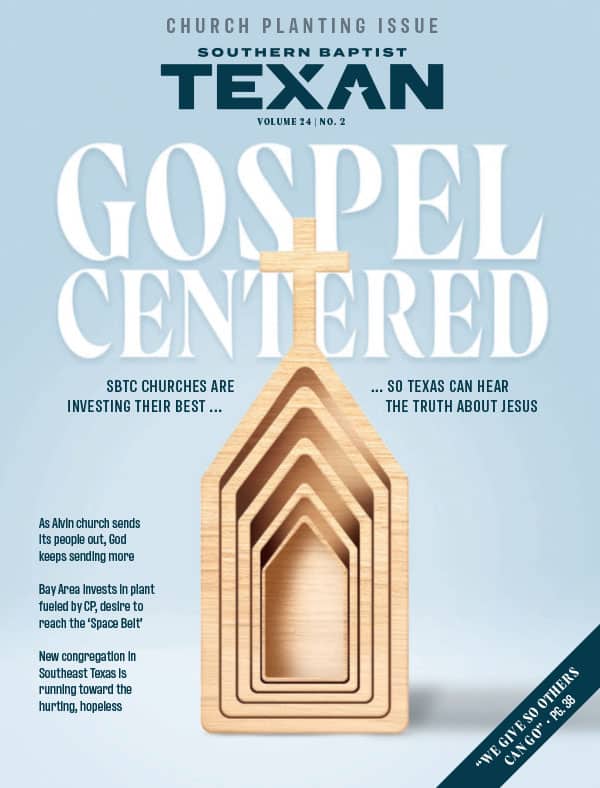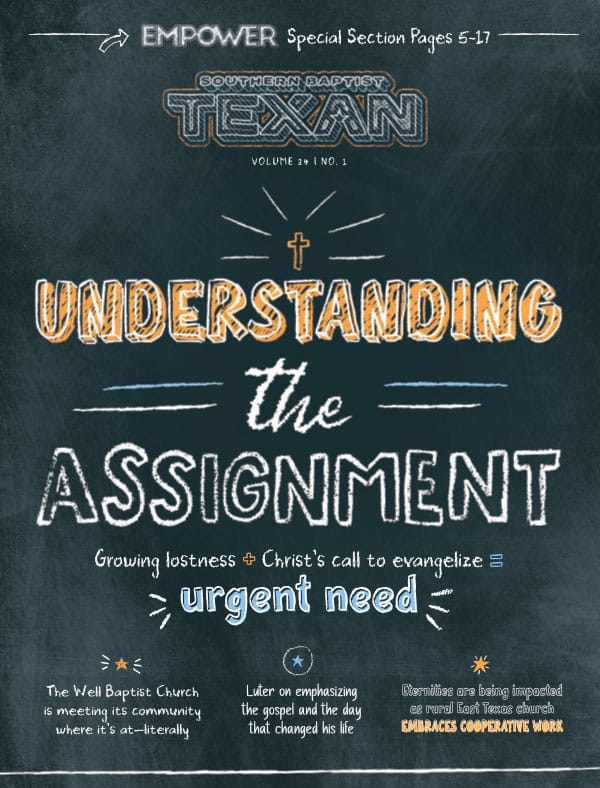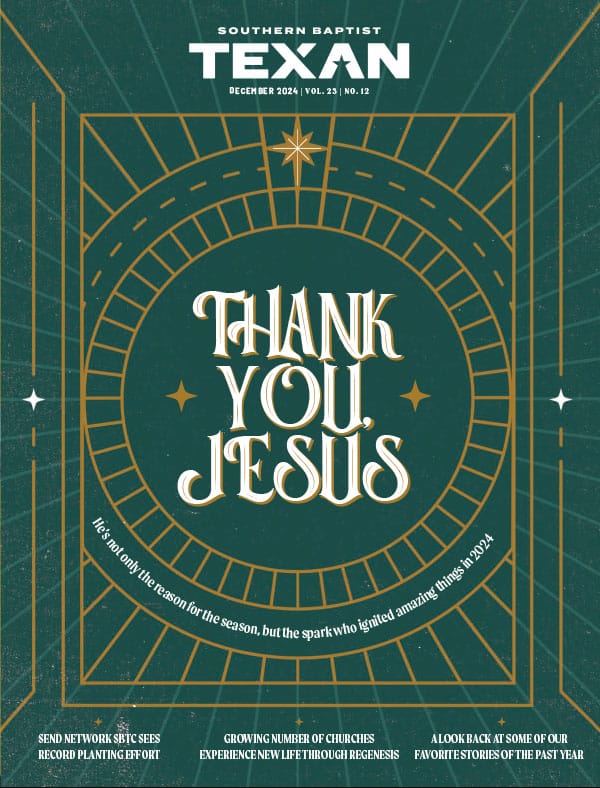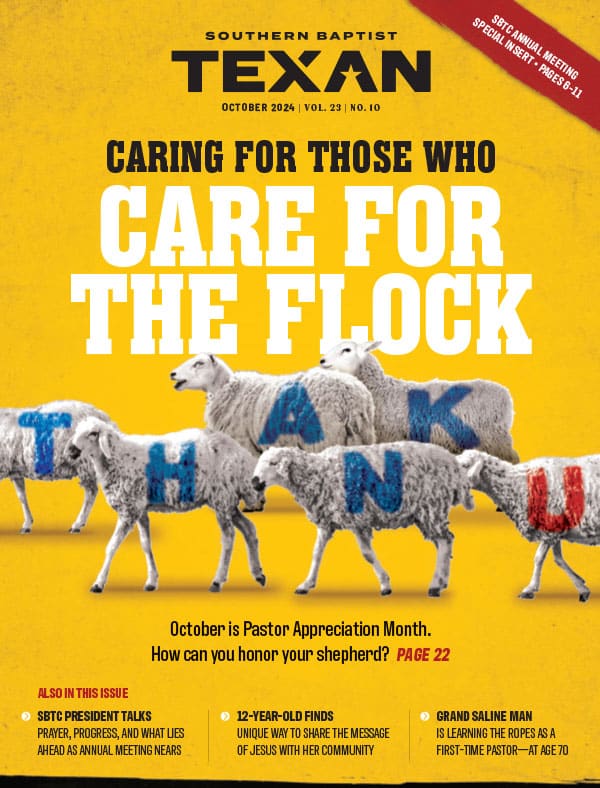Acknowledging the increasing spiritual lostness in the Lone Star State and the evangelistic success of new churches, the SBTC has made the connection and developed ambitious plans to reach Texas for Christ through biblical church planting.
“A key ingredient to successful church planting, regardless of the model, is the planter himself,” said Terry Coy, SBTC missions director. That’s why the convention has matched its ambitious church planting strategy with a rigorous screening and approval process for each applicant.
“The process is long and arduous,” said Brady Blevins, SBTC church planter/pastor of The Ridge Baptist Church in Grand Prairie. “I appreciate that the process is difficult because it’s designed to find those men who are called of God and are ready to start a new church.”
“The assessment and training processes are amazing,” added Danny Price, SBTC church planter and pastor of Hope Community Church in San Antonio. “They can really encourage a church planter and help clarify his vision from God.”
The qualification process also ensures that the prospective planter’s theology and doctrine are distinctly biblical and unmistakably baptistic.
“We also assess how a church planter is wired,” Coy said. “We assess his personality, giftedness, leadership qualities and entrepreneurial skills. Can he start something and see it through?”
“I love it that they are willing to look you in the eye and say, ‘We don’t think you should be a church planter’ because some guys aren’t qualified or ready,” said Zak White, planter/pastor of Revolution Church in Schertz. “The SBTC weeds out those who may launch and fail, and then give the effort a bad reputation.”
The assessment process includes several critical questions, like these two: “Who is God calling you to reach? How has God uniquely wired and prepared you to reach them?”
Such questions help avoid a common mistake, and that is a planter who is intent on a specific model of church plant, but who hasn’t researched and exegeted the local culture to see if the model will fit the group or community he’s trying to reach.
Once such issues are settled, and the planter embraces the principle that church planting itself supersedes any consideration of style and model, then the assessment process may continue.
“We also want our planters to remember that the Great Commission is about making disciples,” Coy said. “Nowhere does Jesus command that we plant churches. However, we believe the best way to fulfill the Great Commission is through church planting.”
A common question among prospective planters is: “What qualifies as a church plant?”
The SBTC defines a church plant as being led by a planter, who has successfully completed the church planting process of sponsorship, assessment, and training, and is focused on reaching a clearly defined and previously unreached group of people. That means the new church isn’t competing for existing Christians, but is committed to growth primarily by conversions. Beyond its own growth, the new church must see the multiplication of itself as its reason for being, and as a means to expand the kingdom of God beyond its own walls.
Prospective planters are free to ask any questions during the qualification process, but they also will be asked such questions as:
-
Are you in agreement with the Baptist Faith and Message 2000?
-
Do you practice public or private glossolalia (speaking in tongues)?
-
Have you consumed alcohol as a beverage in the last 12 months?
-
Have you or your spouse ever been divorced?
-
Are you currently affiliated, or planning to affiliate with a church planting network?
Planters are encouraged to expand their supportive networks or sponsorships. However, each planter must be sponsored by an SBTC-affiliated church. That strong relationship with one or more sponsoring churches is key to successful church planting, according to Coy and other missions staff.
Barry Calhoun, the SBTC’s church planting team leader, said the role of a sponsoring church may vary, according to the needs of the church plant and the desire of the sponsoring church.
“A sponsor may be a seeding church that sends a team with the planter to start the plant, provide monthly to the budget, a lump sum to the budget or specific equipment or office supplies,” he said. “Some sponsors might send teams to help with surveys, block parties or provide administrative help with accounting. The range of opportunities for sponsoring churches is vast.”
First Baptist Church of Pflugerville serves as the sponsoring church for Abundant Life Community Baptist Church in Pflugerville where DeChard Freeman serves as pastor.
“Church planting helps First Pflugerville keep our focus on sharing Christ with people—especially those who may be better reached by another church,” explained Mike Northen, missions pastor at FBCP. “We are open for all to worship and serve Christ at FBCP but we cannot reach everyone. If we can’t, then who can? Starting new churches is the answer. It is part of our response to Jesus’ Acts 1:8 directive.”
Northen said any church that puts a priority on reaching people for Christ can participate with establishing a new church.
“It is not a financial or leadership decision but a commitment to be an Acts 1:8 church and allowing God to provide the resources needed. He may only want you to provide printing or mentoring, prayer or simply building space for them to hold their services,” he suggested. “Be available as a church.”
Leon Moore at Mesquite Friendship Baptist Church serves in the areas of evangelism and discipleship and shared how his pastor, Terry Turner, set the vision for church planting about five years ago. The Mesquite church offers counsel in different areas of church life and has provided other types of support in planting Trinity Friendship Baptist Church of Wylie where Raymond Perry serves as pastor.
“Church planting is a challenge,” Moore told the TEXAN. “It looks nice on Sunday morning but there’s a lot of work that goes into having a successful church that Christ would be proud of.” He said the ministers of Mesquite Friendship Baptist work as a team alongside the church planter.
“The brother that is leading that church knows it has a great potential for growth and will yield many benefits to the kingdom.”
In addition to ensuring church planters have a strong network of sponsors, candidates are asked about their evangelistic experiences outside of a church event or setting, whether the planter’s wife is supportive of his call to plant a church, and a willingness to serve bi-vocationally or receive a salary that is smaller than what is currently earned. In fact, Calhoun said about 95 percent of church planters he works with are bi-vocational, at least for the first few years.
The SBTC provides a portion of a church plant’s operating budget, but even with all the sponsors contributing, few plants can support a pastor’s salary.
And because Cooperative Program receipts help fund church plants, every receiving church plant in turn agrees to a covenant of supporting the CP as soon as they affiliate, in the range of 6-10 percent of undesignated receipts.
“I won’t say our church wouldn’t exist without the Cooperative Program, because I believe God wanted to see my church planting desires fulfilled,” said White of Revolution Church. “However, we value the CP, and our people love it. We’ve been giving to it all along. It’s a great strategy and a great strength. Even a church as young as we are—a toddler church—we can be a part of helping to plant other churches. We call it ‘kingdom equity.’”
Every prospective planter must either complete the SBTC’s Basic Training Journey—a three-day workshop to prepare the planter, spouse and up to three core leaders for the rigors of planting—or an approved training elsewhere.
The SBTC also requires ongoing training, some of it from its extensive network of church planting coaches.
Brett Stair, planter/pastor of the Church at Sendera Ranch in Haslet, said. “It’s been a great experience to be an SBTC church planter, especially the training and resourcing that a church planter needs.”
White expressed gratitude for the on-going training, mentoring and wisdom of the SBTC church planter coaches. “I think it would be stupid not to tap into the wisdom of church planting coaches as those who’ve gone farther, faster. They tell you the dangers and the pitfalls.”
One such coach is Sam Douglas, of whom White said, “He has saved us from making financial, strategic and logistical mistakes. He is amazing.”
Blevins commends the SBTC to prospective church planters because “the convention cares about you as a person, your church and the equipping that is necessary to be a successful church planter. The SBTC wants to see the kingdom of God expanded, and they are willing to do what it takes to make that happen. As a church planter there is nothing more that you could ask out of a supporting organization.”
“The entire process is the best I’ve ever seen,” said Scott Mills, planter/pastor of Harvest Church in Martindale. “Not only do [SBTC leaders] do a thorough job of screening applicants, one of my favorite things they kept harping on was ‘Are you called?’
“When I asked why they kept harping on this, the answer was: ‘What matters most is that the man of God is called to the area; God will take care of everything else. We want you to remember this,’” recounted Mills.
“I have clung to that thought many times.”
For more information on SBTC church planting, visit sbtexas.com/churchplanting.










